Essential Oil Headspace Volatiles Prevent Invasive Box Tree Moth (Cydalima perspectalis) Oviposition—Insights from Electrophysiology and Behaviour
Abstract
1. Introduction
2. Materials and Methods
2.1. Insects
2.2. Essential Oils and Dispensers
2.3. Oviposition Bioassay
2.4. SPME Volatile Collections and GC-MS Analysis
2.5. Electrophysiological Experiments of SPME Headspace (GC-EAD)
2.6. Dispenser Release Rate and Longevity Analysis by SPME Sampling
2.7. Statistical Analysis
3. Results
3.1. Oviposition Bioassay
3.2. Chemical and Chemosensory Characterisation of EOs
3.2.1. Cinnamon
3.2.2. Eucalyptus
3.2.3. Lavender
3.3. Temporal Changes of the Dispenser Emitted Volatiles
4. Discussion
5. Conclusions
Supplementary Materials
Author Contributions
Funding
Acknowledgments
Conflicts of Interest
References
- di Castri, F. History of biological invasions with special emphasis on the old world. In Biological Invasions: A Global Perspective; John Wiley and Sons: Chichester, UK, 1989; pp. 1–30. ISBN 0-471-92085-1. [Google Scholar]
- Meyerson, L.A.; Mooney, H.A. Invasive alien species in an era of globalization. Front. Ecol. Environ. 2007, 5, 199–208. [Google Scholar] [CrossRef]
- Leuthardt, F.L.G.; Billen, W.; Baur, B. Ausbreitung des buchsbaumzünslers Diaphania perspectalis (Lepidoptera: Pyralidae) in der region Basel–eine für die Schweiz neue schädlingsart. Entomo Helvetica 2010, 2, 51–57. [Google Scholar]
- van der Straten, M.; Muus, T.S.T. The box tree pyralid (Glyphodes perspectalis (Walker, 1859), Lepidoptera: Crambidae); an invasive alien moth ruining box trees. In Proceedings of the Netherlands Entomological Society, Wageningen, The Netherlands, 1 April 2010; Volume 21, pp. 107–111. [Google Scholar]
- Leuthardt, F.L.G.; Baur, B. Oviposition preference and larval development of the invasive moth Cydalima perspectalis on five European box-tree varieties. J. Appl. Entomol. 2013, 137, 437–444. [Google Scholar] [CrossRef]
- Wan, H.; Haye, T.; Kenis, M.; Nacambo, S.; Xu, H.; Zhang, F.; Li, H. Biology and natural enemies of Cydalima perspectalis in Asia: Is there biological control potential in Europe? J. Appl. Entomol. 2014, 138, 715–722. [Google Scholar] [CrossRef]
- Kenis, M.; Nacambo, S.; Leithardt, F.L.G.; di Domenico, F.; Haye, T. The box tree moth, Cydalima perspectalis, in Europe: Horticultural pest or environmental disaster? Aliens Invasive Species Bull. 2013, 33, 38–41. [Google Scholar]
- John, R.; Schumacher, J. Der buchsbaum-zünsler (Cydalima perspectalis) im Grenzach-Wyhlener buchswald–invasionschronik und monitoringergebnisse. Gesunde Pflanz. 2013, 65, 1–6. [Google Scholar] [CrossRef]
- Mitchell, R.; Chitanava, S.; Dbar, R.; Kramarets, V.; Lehtijärvi, A.; Matchutadze, I.; Mamadashvili, G.; Matsiakh, I.; Nacambo, S.; Papazova-Anakieva, I.; et al. Identifying the ecological and societal consequences of a decline in buxus forests in Europe and the Caucasus. Biol. Invasions 2018, 20, 3605–3620. [Google Scholar] [CrossRef]
- Kawazu, K.; Honda, H.; Nakamura, S.; Adati, T. Identification of sex pheromone components of the box tree pyralid, Glyphodes perspectalis. J. Chem. Ecol. 2007, 33, 1978–1985. [Google Scholar] [CrossRef]
- Santi, F.; Radeghieri, P.; Inga Sigurtá, G.; Maini, S. Sex pheromone traps for detection of the invasive box tree moth in Italy. Bull. Insectology 2015, 66, 158–160. [Google Scholar]
- Martin, J.C.; Brinquin, A.S.; Morel, E.; Tabone, E.; Guerin, M. New regulation tool for borer boxwood Cydalima perspectalis (Walker): A highly attractive pheromone and trap kit. In Proceedings of the 5th Conférence Internationale sur les Méthodes Alternatives de Protection des Plantes, Nouceau Sièle, Lille, France, 11–13 March 2015; pp. 701–709. [Google Scholar]
- Choochote, W.; Chaithong, U.; Kamsuk, K.; Jitpakdi, A.; Tippawangkosol, P.; Tuetun, B.; Champakaew, D.; Pitasawat, B. Repellent activity of selected essential oils against Aedes aegypti. Fitoterapia 2007, 78, 359–364. [Google Scholar] [CrossRef]
- Brown, M.; Hebert, A.A. Insect repellents: An overview. J. Am. Acad. Dermatol. 1997, 36, 243–249. [Google Scholar] [CrossRef]
- Molnár, B.P.; Tóth, Z.; Kárpáti, Z. Synthetic blend of larval frass volatiles repel oviposition in the invasive box tree moth, Cydalima perspectalis. J. Pest Sci. 2017, 90, 873–885. [Google Scholar] [CrossRef]
- Sukumar, K.; Perich, M.J.; Boobar, L.R. Botanical derivatives in mosquito control: A Review. J. Am. Mosq. Control Assoc. 1991, 7, 210. [Google Scholar] [PubMed]
- Hüsnü Can Baser, K.; Buchbauer, G. Handbook of Essential Oils Science, Technology and Applications, 2nd ed.; CRC Press: Boca Raton, FL, USA, 2015; ISBN 1-4665-9046-7. [Google Scholar]
- Németh-Zámbori, É.; Rajhárt, P.; Inotai, K. Effect of genotype and age on essential oil and total phenolics in hyssop (Hyssopus officinalis L.). J. Appl. Bot. Food Qual. 2017, 90. [Google Scholar] [CrossRef]
- Verma, R.S.; Padalia, R.C.; Chauhan, A. Harvesting season and plant part dependent variations in the essential oil composition of Salvia officinalis L. grown in northern India. J. Herb. Med. 2015, 5, 165–171. [Google Scholar] [CrossRef]
- de Souza Junior, E.T.; Siqueira, L.M.; Almeida, R.N.; Lucas, A.M.; da Silva, C.G.F.; Cassel, E.; Vargas, R.M.F. Comparison of different extraction techniques of Zingiber officinale essential oil. Braz. Arch. Biol. Technol. 2020, 63, e20190213. [Google Scholar] [CrossRef]
- Pybus, D.; Sell, C. The Chemistry of Fragrances: From Perfumer to Consumer, 2nd ed.; Royal Society of Chemistry: Cambridge, UK, 2007; ISBN 978-0-85404-824-3. [Google Scholar]
- Dhifi, W.; Bellili, S.; Jazi, S.; Bahloul, N.; Mnif, W. Essential oils’ chemical characterization and investigation of some biological activities: A critical review. Medicines 2016, 3, 25. [Google Scholar] [CrossRef]
- Akhtar, Y.; Pages, E.; Stevens, A.; Bradbury, R.; da CAMARA, C.A.G.; Isman, M.B. Effect of chemical complexity of essential oils on feeding deterrence in larvae of the cabbage looper. Physiol. Entomol. 2012, 37, 81–91. [Google Scholar] [CrossRef]
- Taghizadeh Saroukolai, A.; Nouri-Ganbalani, G.; Hadian, J.; Rafiee-Dastjerdi, H. Antifeedant activity and toxicity of some plant essential oils to Colorado potato beetle, Leptinotarsa decemlineata Say (Coleoptera: Chrysomelidae). Plant Prot. Sci. 2014, 50, 207–216. [Google Scholar] [CrossRef]
- Lee, B.-H.; Choi, W.-S.; Lee, S.-E.; Park, B.-S. Fumigant toxicity of essential oils and their constituent compounds towards the rice weevil, Sitophilus oryzae (L.). Crop Prot. 2001, 20, 317–320. [Google Scholar] [CrossRef]
- Yi, C.-G.; Kwon, M.; Hieu, T.T.; Jang, Y.-S.; Ahn, Y.-J. Fumigant toxicity of plant essential oils to Plutella xylostella (Lepidoptera: Yponomeutidae) and Cotesia glomerata (Hymenoptera: Braconidae). J. Asia-Pac. Entomol. 2007, 10, 157–163. [Google Scholar] [CrossRef]
- Ghabbari, M.; Guarino, S.; Caleca, V.; Saiano, F.; Sinacori, M.; Baser, N.; Mediouni-Ben Jemâa, J.; Lo Verde, G. Behavior-modifying and insecticidal effects of plant extracts on adults of Ceratitis capitata (Wiedemann) (Diptera Tephritidae). J. Pest Sci. 2018, 91, 907–917. [Google Scholar] [CrossRef]
- Jayakumar, M. Oviposition deterrent and adult emergence activities of some plant aqueous extracts against Callosobruchus maculatus F. (Coleoptera: Bruchidae). J. Biopestic. 2010, 3, 325–329. [Google Scholar]
- Morey, R.; Khandagle, A. Bioactivity of plant essential oil against potato tuber moth, Phthorimaea operculella Zeller (Lepidoptera: Gelechiidae). Egypt. Acad. J. Biol. Sci. Entomol. 2020, 13, 51–56. [Google Scholar] [CrossRef][Green Version]
- Ribeiro, R.C.; Zanuncio, T.V.; de Ramalho, F.S.; da Silva, C.A.D.; Serrão, J.E.; Zanuncio, J.C. Feeding and oviposition of Anticarsia gemmatalis (Lepidoptera: Noctuidae) with sublethal concentrations of ten condiments essential oils. Ind. Crops Prod. 2015, 74, 139–143. [Google Scholar] [CrossRef]
- Aly, M.; Ali, A. Impact of some essential plant oils and insect growth regulators on immature stages of Spodoptera littoralis (Boisd.) (Lepidoptera: Noctuidae) in Egypt. J. Plant Prot. Pathol. 2017, 8, 561–570. [Google Scholar] [CrossRef]
- Lourenço, A.M.; Haddi, K.; Ribeiro, B.M.; Corrêia, R.F.T.; Tomé, H.V.V.; Santos-Amaya, O.; Pereira, E.J.G.; Guedes, R.N.C.; Santos, G.R.; Oliveira, E.E.; et al. Essential oil of Siparuna guianensis as an alternative tool for improved lepidopteran control and resistance management practices. Sci. Rep. 2018, 8, 7215. [Google Scholar] [CrossRef]
- Yarou, B.B.; Bawin, T.; Boullis, A.; Heukin, S.; Lognay, G.; Verheggen, F.J.; Francis, F. Oviposition deterrent activity of basil plants and their essentials oils against Tuta absoluta (Lepidoptera: Gelechiidae). Environ. Sci. Pollut. Res. 2018, 25, 29880–29888. [Google Scholar] [CrossRef]
- Göttig, S.; Korn, S.; Herz, A. Repellent and toxic properties of plant oils and extracts on Cydalima perspectalis Walker (Lepidoptera: Crambidae). Arch. Phytopathol. Plant Prot. 2017, 50, 658–673. [Google Scholar] [CrossRef]
- Oliveira, M.A.; Gonzaga, M.L.C.; Bastos, M.S.R.; Magalhães, H.C.R.; Benevides, S.D.; Furtado, R.F.; Zambelli, R.A.; Garruti, D.S. Packaging with cashew gum/gelatin/essential oil for bread: Release potential of the citral. Food Packag. Shelf Life 2020, 23, 100431. [Google Scholar] [CrossRef]
- Jovanović, J.; Krnjajić, S.; Ćirković, J.; Radojković, A.; Popović, T.; Branković, G.; Branković, Z. Effect of encapsulated lemongrass (Cymbopogon citratus L.) essential oil against potato tuber moth Phthorimaea operculella. Crop Prot. 2020, 132, 105109. [Google Scholar] [CrossRef]
- Adak, T.; Barik, N.; Patil, N.B.; Govindharaj, G.-P.-P.; Gadratagi, B.G.; Annamalai, M.; Mukherjee, A.K.; Rath, P.C. Nanoemulsion of eucalyptus oil: An alternative to synthetic pesticides against two major storage insects (Sitophilus oryzae (L.) and Tribolium castaneum (Herbst)) of rice. Ind. Crops Prod. 2020, 143, 111849. [Google Scholar] [CrossRef]
- Molnár, B.P.; Tóth, Z.; Fejes-Tóth, A.; Dekker, T.; Kárpáti, Z. Electrophysiologically-active maize volatiles attract gravid female European corn borer, Ostrinia nubilalis. J. Chem. Ecol. 2015, 41, 997–1005. [Google Scholar] [CrossRef] [PubMed]
- Stensmyr, M.C.; Dweck, H.K.M.; Farhan, A.; Ibba, I.; Strutz, A.; Mukunda, L.; Linz, J.; Grabe, V.; Steck, K.; Lavista-Llanos, S.; et al. A conserved dedicated olfactory circuit for detecting harmful microbes in Drosophila. Cell 2012, 151, 1345–1357. [Google Scholar] [CrossRef] [PubMed]
- R Core Team. A Language and Environment for Statistical Computing. R Foundation for Statistical Computing. Available online: https://www.R-project.org/ (accessed on 29 February 2020).
- Lee, M.Y. Essential oils as repellents against arthropods. BioMed Res. Int. 2018, 2018, 1–9. [Google Scholar] [CrossRef] [PubMed]
- Oh, J.-H.M. The acaricidal and repellent effect of cinnamon essential oil against house dust mite. World Acad. Sci. Eng. Technol. 2011, 60, 710–714. [Google Scholar] [CrossRef]
- Peach, D.A.H.; Almond, M.; Gries, R.; Gries, G. Lemongrass and cinnamon bark: Plant essential oil blend as a spatial repellent for mosquitoes in a field setting. J. Med. Entomol. 2019, 56, 1346–1352. [Google Scholar] [CrossRef]
- Landolt, P.J.; Hofstetter, R.W.; Biddick, L.L. Plant essential oils as arrestants and repellents for neonate larvae of the codling moth (Lepidoptera: Tortricidae). Environ. Entomol. 1999, 28, 954–960. [Google Scholar] [CrossRef]
- Fouad, H.A. Effect of five essential oils as repellents against the cowpea beetle, Callosobruchus maculates (F.). Bull. Environ. Pharmacol. Life Sci. 2013, 2, 23–27. [Google Scholar]
- Deletre, E.; Chandre, F.; Williams, L.; Duménil, C.; Menut, C.; Martin, T. Electrophysiological and behavioral characterization of bioactive compounds of the Thymus vulgaris, Cymbopogon winterianus, Cuminum cyminum and Cinnamomum zeylanicum essential oils against Anopheles gambiae and prospects for their use as bednet treatments. Parasit. Vectors 2015, 8, 316. [Google Scholar] [CrossRef]
- Ayyub, C.; Paranjape, J.; Rodrigues, V.; Siddiqi, O. Genetics of olfactory behavior in Drosophila melanogaster. J. Neurogenet. 1990, 6, 243–262. [Google Scholar] [CrossRef] [PubMed]
- Nerio, L.S.; Olivero-Verbel, J.; Stashenko, E. Repellent activity of essential oils: A review. Bioresour. Technol. 2010, 101, 372–378. [Google Scholar] [CrossRef] [PubMed]
- Sangha, J.S.; Astatkie, T.; Cutler, G.C. Ovicidal, larvicidal, and behavioural effects of some plant essential oils on diamondback moth (Lepidoptera: Plutellidae). Can. Entomol. 2017, 149, 639–648. [Google Scholar] [CrossRef]
- Tripathi, A.K.; Mishra, S. Plant monoterpenoids (prospective pesticides). In Ecofriendly Pest Management for Food Security; Elsevier: San Diego, USA, 2016; Volume 16, pp. 507–524. ISBN 978-0-12-803265-7. [Google Scholar]
- Szelényi, M.O.; Erdei, A.L.; Molnár, B.P. Laboratory and semi-field studies with lavender volatiles on female-targeted lure for the box tree moth (Cydalima perspectalis). Unpublished work.
- Lanceau, Y. La Pyrale du Buis, un Passager Clandestin Venu d’Orient. Available online: https://vimeo.com/292458709 (accessed on 29 September 2018).
- Reisenman, C.E.; Riffell, J.A.; Bernays, E.A.; Hildebrand, J.G. Antagonistic effects of floral scent in an insect–plant interaction. Proc. R. Soc. B Biol. Sci. 2010, 277, 2371–2379. [Google Scholar] [CrossRef]
- Zito, P.; Guarino, S.; Peri, E.; Sajeva, M.; Colazza, S. Electrophysiological and behavioural responses of the housefly to “sweet” volatiles of the flowers of Caralluma europaea (Guss.) N.E. Br. Arthropod-Plant Interact. 2013, 7, 485–489. [Google Scholar] [CrossRef]
- Meza, F.C.; Roberts, J.M.; Sobhy, I.S.; Okumu, F.O.; Tripet, F.; Bruce, T.J.A. Behavioural and electrophysiological responses of female Anopheles gambiae mosquitoes to volatiles from a mango bait. J. Chem. Ecol. 2020, 46, 387–396. [Google Scholar] [CrossRef]
- Stauffer, E.; Dolan, J.A.; Newman, R. Fire Debris Analysis; Academic Press: Boston, MA, USA, 2008; ISBN 9780126639711. [Google Scholar]
- Treibs, W. Gewinnung atherischer Öle durch destillation, extraktion und pressung. A. Einleitung. In Die Atherischen Öle Band I.; Akademia-Verlag: Berlin, Germany, 1956; pp. 307–309. [Google Scholar]
- Turek, C.; Stintzing, F.C. Stability of essential oils: A Review. Compr. Rev. Food Sci. Food Saf. 2013, 12, 40–53. [Google Scholar] [CrossRef]
- Scott, R.P.W. Essential oils. In Encyclopedia of Analytical Science; Elsevier: Amsterdam, The Netherlands; London, UK; New York, NY, USA, 2005; pp. 554–561. [Google Scholar]
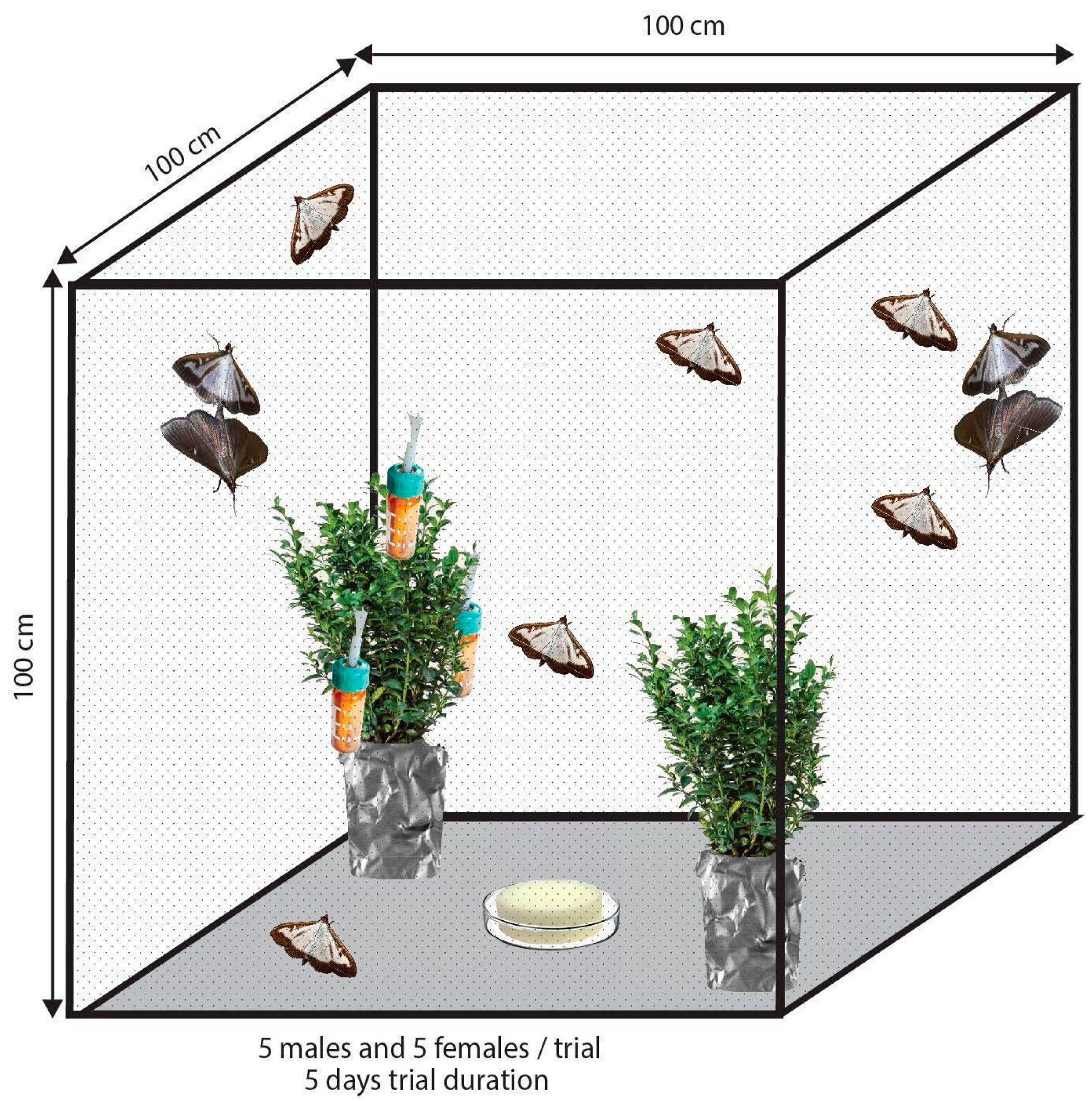
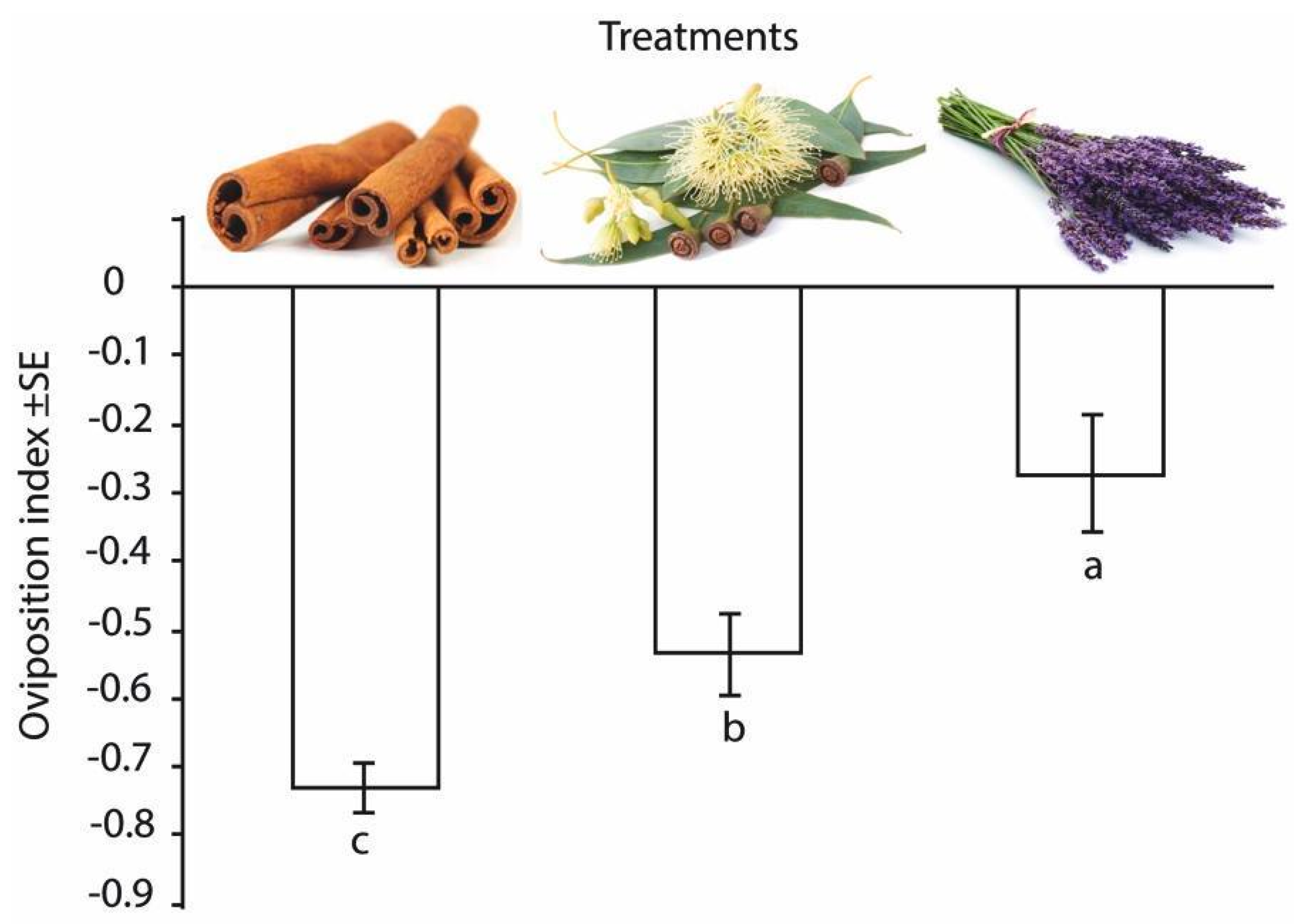
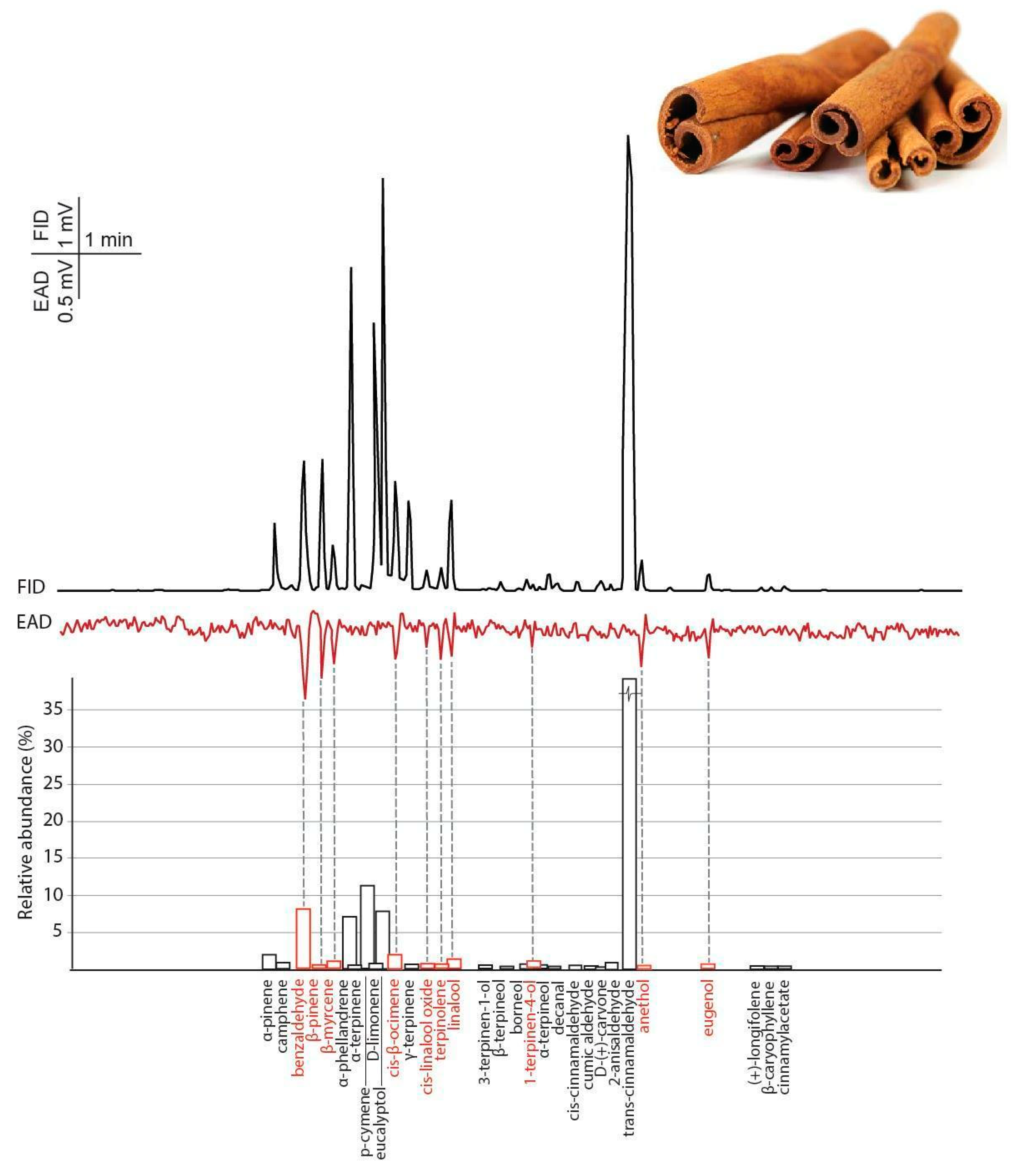
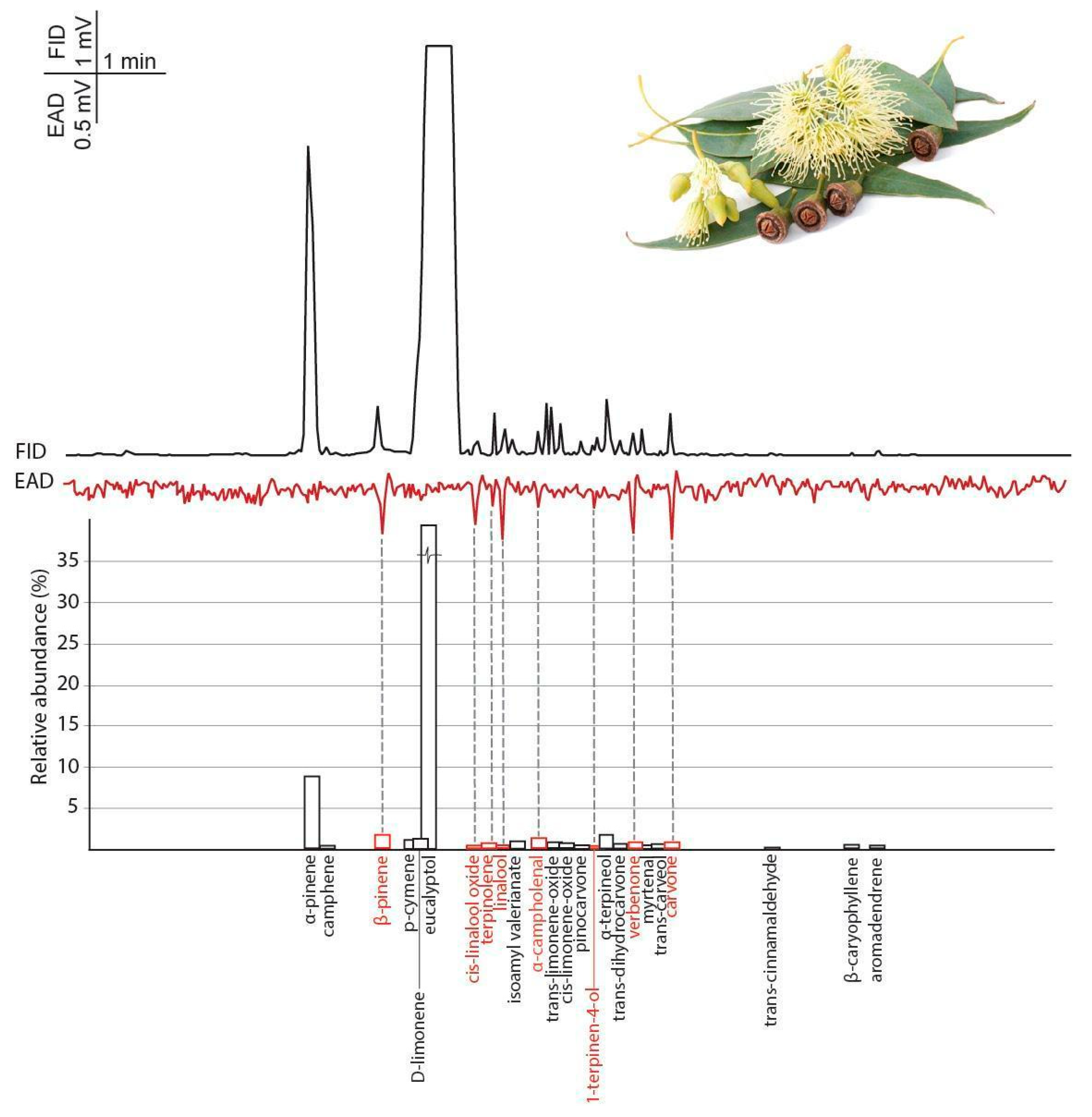
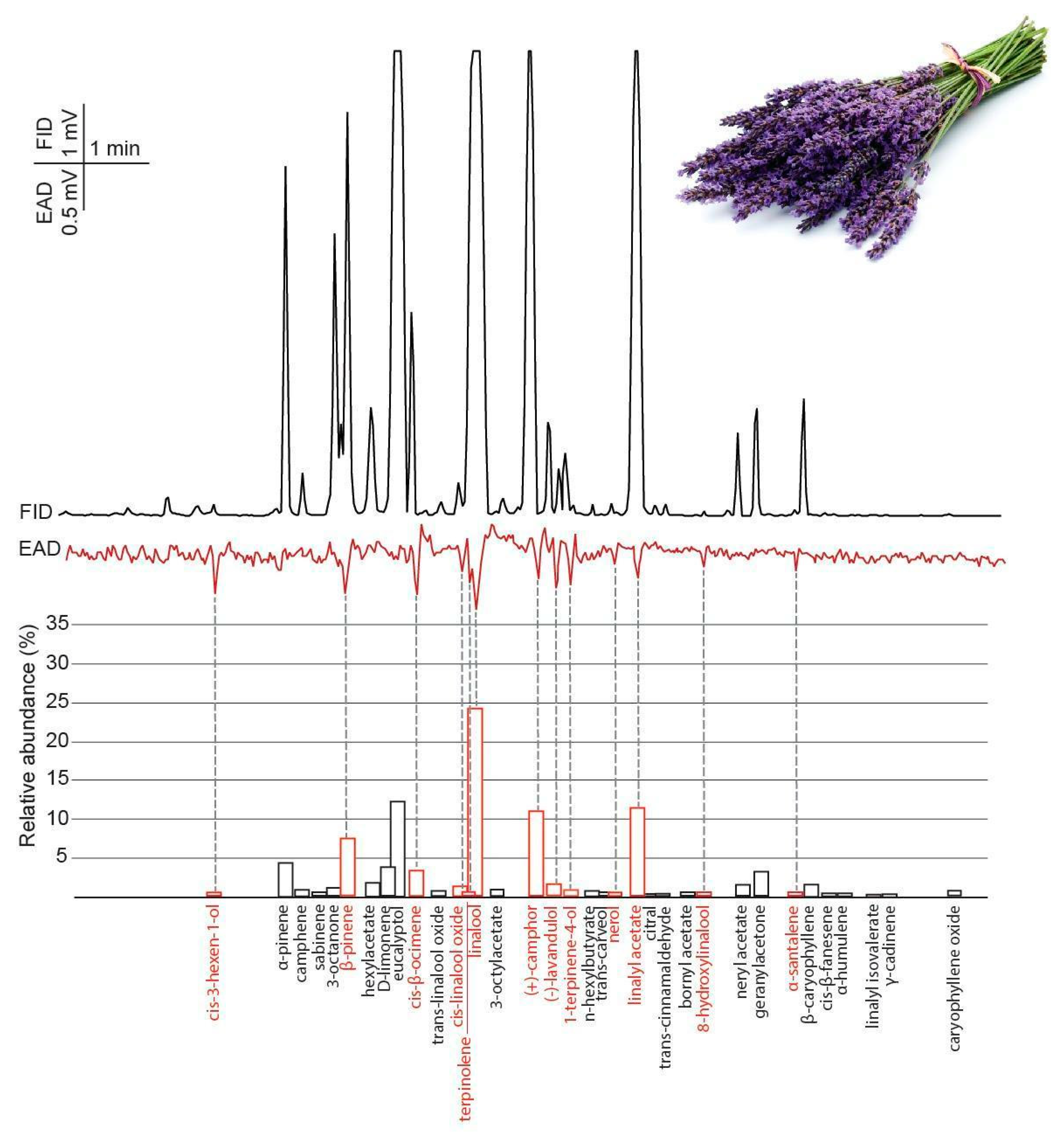
 |  |  | ||||||
|---|---|---|---|---|---|---|---|---|
| # | RI NIST | RI Calc. | ∆RI | CAS | Compounds | Relative Content (%) | ||
| 1 | 855 | 860 | 5 | 928-96-1 | cis-3-hexen-1-ol | - | - | 0.03 |
| 2 | 966 | 969 | 3 | 100-52-7 | benzaldehyde | 8.23 | - | - |
| 3 | 980 | 988 | 8 | 127-91-3 | β-pinene | 0.20 | 1.54 | 6.70 |
| 4 | 992 | 997 | 5 | 123-35-3 | β-myrcene | 0.46 | - | - |
| 5 | 1037 | 1056 | 19 | 3338-55-4 | cis-β-ocimene | 1.50 | - | 3.32 |
| 6 | 1078 | 1080 | 2 | 5989-33-3 | cis-linalool oxide | 0.05 | 0.11 | 0.672 |
| 7 | 1090 | 1096 | 6 | 586-62-9 | terpinolene | 0.18 | 0.57 | 0.34 |
| 8 | 1100 | 1104 | 4 | 78-70-6 | linalool | 0.80 | 0.05 | 24.07 |
| 9 | 1140 | 1162 | 18 | 91,819-58-8 | α-campholenal | - | 0.77 | - |
| 10 | 1150 | 1140 | 10 | 464-49-3 | (+)-camphor | 0.26 | - | 11.70 |
| 11 | 1165 | 1176 | 11 | nd | (-)-lavandulol | - | - | 0.06 |
| 12 | 1177 | 1192 | 15 | 562-74-3 | 1-terpinen-4-ol | 0.98 | 0.06 | 0.39 |
| 13 | 1206 | 1223 | 17 | 80-57-9 | verbenone | - | 0.40 | - |
| 14 | 1239 | 1238 | 1 | 106-25-2 | nerol | - | - | 0.05 |
| 15 | 1254 | 1256 | 2 | 99-49-0 | carvone | - | 0.66 | - |
| 16 | 1257 | 1268 | 11 | 115-95-7 | linalyl acetate | - | - | 11.76 |
| 17 | 1289 | 1295 | 6 | 104-46-1 | anethol | 0.52 | - | - |
| 18 | 1355 | 1356 | 1 | 64,142-78-5 | 8-hydroxylinalool | - | - | 0.01 |
| 19 | 1359 | 1367 | 8 | 97-53-0 | eugenol | 0.01 | - | - |
| 20 | 1420 | 1437 | 17 | 512-61-8 | α-santalene | - | - | 0.03 |
| Coefficients | Std. Error | p Value | 95% Confidence Interval | |||
|---|---|---|---|---|---|---|
| Cinnamon | β-pinene | 58,508 | 9358 | 0.000 * | 38,293 | 78,724 |
| cis-linalool oxide | 763,329 | 200,623 | 0.002 * | 329,909 | 1,196,749 | |
| terpinolene | 2,867,102 | 1,109,690 | 0.023 * | 469,763 | 5,264,441 | |
| linalool | 186,612 | 82,758 | 0.042 * | 7825 | 365,399 | |
| 1-terpinen-4-ol | 136,870 | 21,533 | 0.000 * | 90,351 | 183,389 | |
| Eucalyptus | β-pinene | −6,317,955 | 3,663,618 | 0.108 | −14,232,721 | 1,596,811 |
| cis-linalool oxide | −2,130,450 | 355,777 | 0.000 * | −299,058 | −1,361,841 | |
| terpinolene | −305,624 | 112,878 | 0.018 * | −549,481 | −61,767 | |
| linalool | −258,880 | 95,804 | 0.018 * | −465,851 | −51,908 | |
| 1-terpinen-4-ol | −469,621 | 89,026 | 0.000 * | −661,949 | −277,293 | |
| Lavender | β-pinene | −4,545,632 | 1,623,038 | 0.015 * | −8,051,994 | −1,039,271 |
| cis-linalool oxide | −247,724 | 81,186 | 0.009 * | −423,115 | −72,333 | |
| terpinolene | −13,890,875 | 7,393,673 | 0.088 | −29,863,934 | 2,082,183 | |
| linalool | −5,950,558 | 1,698,063 | 0.004 * | −9,618,999 | −2,282,117 | |
| 1-terpinen-4-ol | −347,161 | 153,093 | 0.041 * | −677,897 | −16,424 | |
© 2020 by the authors. Licensee MDPI, Basel, Switzerland. This article is an open access article distributed under the terms and conditions of the Creative Commons Attribution (CC BY) license (http://creativecommons.org/licenses/by/4.0/).
Share and Cite
Szelényi, M.O.; Erdei, A.L.; Jósvai, J.K.; Radványi, D.; Sümegi, B.; Vétek, G.; Molnár, B.P.; Kárpáti, Z. Essential Oil Headspace Volatiles Prevent Invasive Box Tree Moth (Cydalima perspectalis) Oviposition—Insights from Electrophysiology and Behaviour. Insects 2020, 11, 465. https://doi.org/10.3390/insects11080465
Szelényi MO, Erdei AL, Jósvai JK, Radványi D, Sümegi B, Vétek G, Molnár BP, Kárpáti Z. Essential Oil Headspace Volatiles Prevent Invasive Box Tree Moth (Cydalima perspectalis) Oviposition—Insights from Electrophysiology and Behaviour. Insects. 2020; 11(8):465. https://doi.org/10.3390/insects11080465
Chicago/Turabian StyleSzelényi, Magdolna Olívia, Anna Laura Erdei, Júlia Katalin Jósvai, Dalma Radványi, Bence Sümegi, Gábor Vétek, Béla Péter Molnár, and Zsolt Kárpáti. 2020. "Essential Oil Headspace Volatiles Prevent Invasive Box Tree Moth (Cydalima perspectalis) Oviposition—Insights from Electrophysiology and Behaviour" Insects 11, no. 8: 465. https://doi.org/10.3390/insects11080465
APA StyleSzelényi, M. O., Erdei, A. L., Jósvai, J. K., Radványi, D., Sümegi, B., Vétek, G., Molnár, B. P., & Kárpáti, Z. (2020). Essential Oil Headspace Volatiles Prevent Invasive Box Tree Moth (Cydalima perspectalis) Oviposition—Insights from Electrophysiology and Behaviour. Insects, 11(8), 465. https://doi.org/10.3390/insects11080465






